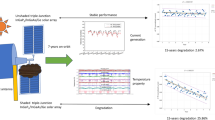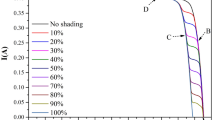Abstract
The practical verification and comparative analysis of one- and two-diode models of a 31.6% efficiency space triple-junction InGaP2/InGaAs/Ge solar cell is presented. Based on the experimental I–V curves of the sub-cells under the air mass 0 (AM0) spectral condition, the diode characteristics of the sub-cells are extracted by the mathematical model of the solar cell diode equivalent circuits. The circuit simulation software, LTSpice, is used to establish the equivalent one-diode and two-diode circuit models of the triple-junction solar cell. The simulation results are compared with the experimental observations of the triple-junction solar cell I–V characteristics under the AM0 spectral condition, demonstrating that the difference in value between the one-diode model and the practical verification cell-in-cell efficiency is 4%, while that of the two-diode model is 0.4%, which may indicate that the two-diode model has better accuracy in the circuit simulation of triple-junction InGaP2/InGaAs/Ge solar cells. This work will be helpful in the structural optimization design of space solar cells and the circuit simulation of spacecraft solar arrays.
Graphical Abstract









Similar content being viewed by others
Data availability
Research data are not shared.
References
A.W. Bett, F. Dimroth, G. Stollwerck, and O. van Sulima, III–V compounds for solar cell applications. Appl. Phys. A 69, 119 (1999).
J. Li et al., A brief review of high efficiency III–V solar cells for space application. Front Phys. 8, 631925 (2021).
O. Saif, M. Abouelatta, A. Shaker, and M.K. Elsaid, On the optimization of InGaP/GaAs/InGaAs triple-junction solar cell. IOP Conf. Ser. Mater Sci. Eng. 446, 012010 (2018).
R. Bibi, A. Ali, and T. Ahmad, Modeling of multi junction solar cell and MPPT. Methods 6, 6 (2019).
Z. Wang, N. Das, A. Helwig, and T. Ahfock, Modeling of multi-junction solar cells for maximum power point tracking to improve the conversion efficiency, in 2017 Australasian Universities Power Engineering Conference (AUPEC) (2017), pp. 1–6.
G. Segev, G. Mittelman, and A. Kribus, Equivalent circuit models for triple-junction concentrator solar cells. Sol. Energy Mater. Sol. Cells 98, 57 (2012).
J.J. Soon, K.-S. Low, and S.T. Goh, Multi-dimension diode photovoltaic (PV) model for different PV cell technologies, in 2014 IEEE 23rd International Symposium on Industrial Electronics (ISIE) (2014), pp. 2496–2501.
T. Ahmad, S. Sobhan, and Md.F. Nayan, Comparative analysis between single diode and double diode model of PV cell: concentrate different parameters effect on its efficiency. J. Power Energy Eng. 04, 31 (2016).
C. Sah, R.N. Noyce, and W. Shockley, Carrier generation and recombination in P–N junctions and P–N junction characteristics. Proc. IRE 45, 1228 (1957).
H. Kawamura, K. Naka, N. Yonekura, S. Yamanaka, H. Kawamura, H. Ohno, and K. Naito, Simulation of I–V characteristics of a PV module with shaded PV cells. Sol. Energy Mater. Sol. Cells 75, 613 (2003).
D.S.H. Chan, J.R. Phillips, and J.C.H. Phang, A comparative study of extraction methods for solar cell model parameters. Solid State Electron 29, 329 (1986).
A. Kassis and M. Saad, Analysis of multi-crystalline silicon solar cells at low illumination levels using a modified two-diode model. Sol. Energy Mater. Sol. Cells 94, 2108 (2010).
A. Hovinen, Fitting of the solar cell IV-curve to the two diode model. Phys. Scr. T54, 175 (1994).
T.J. McMahon, T.S. Basso, and S.R. Rummel, Cell shunt resistance and photovoltaic module performance, in Conference Record of the Twenty Fifth IEEE Photovoltaic Specialists Conference (1996), pp. 1291–1294
W. Abd El-Basit and F. Soliman, Mathematical model for photovoltaic cells. Leonardo J. Sci. 23, 13 (2013).
J.A. Ramos Hernanz, et al., Modelling of photovoltaic module, in International Conference on Renewable Energies and Power Quality (2010).
A. Bouraiou, M. Hamouda, A. Chaker, M. Sadok, M. Mostefaoui, and S. Lachtar, Modeling and simulation of photovoltaic module and array based on one and two diode model using matlab/simulink. Energy Procedia 74, 864 (2015).
S. Stephan, 2/3-Diode Fit.
S. Rißland and O. Breitenstein, Considering the distributed series resistance in a two-diode model. Energy Procedia, 38, 167 (2013).
S. Suckow, T.M. Pletzer, and H. Kurz, Fast and reliable calculation of the two-diode model without simplifications. Prog. Photovolt. Res. Appl. 22, 494 (2014).
H. Rezk and E.-S. Hasaneen, A new MATLAB/simulink model of triple-junction solar cell and MPPT based on artificial neural networks for photovoltaic energy systems. Ain Shams Eng. J. 6, 873 (2015).
M. Steiner, W. Guter, G. Peharz, S.P. Philipps, F. Dimroth, and A.W. Bett, A validated SPICE network simulation study on improving tunnel diodes by introducing lateral conduction layers. Prog. Photovolt. Res. Appl. 20, 274 (2012).
S. Guo, F.-J. Ma, B. Hoex, A.G. Aberle, and M. Peters, Analysing solar cells by circuit modelling. Energy Procedia 25, 28 (2012).
M. Engelhardt, LTSpice/SwitcherCAD IV, Linear Technology Corporation (2011).
M. Khalis, R. Masrour, Y. Mir, and M. Zazoui, Impact of the saturation current IS and ideality factor N on the performance of the characteristic (IV) of a solar cell. Comput. Methods Mater. Sci. 19, 163 (2019).
D.S.H. Chan and J.C.H. Phang, Analytical methods for the extraction of solar-cell single- and double-diode model parameters from I–V characteristics. IEEE Trans. Electron Devices 34, 286 (1987).
X. Ma, S. Bader, and B. Oelmann, On the performance of the two-diode model for photovoltaic cells under indoor artificial lighting. IEEE Access 9, 1350 (2021).
Funding
This work was supported by the National Science Foundation of China (U19376003).
Author information
Authors and Affiliations
Contributions
All authors contributed to the conception and design. Material preparation, data collection, and analysis were performed by Wenqi Zhao, Ning Yang, Jian Li, Liangchao Fang, Wenjia Han, Wenjia Lv, Maoshu Yin, and Jianqin Zhang. The first draft of the manuscript was written by Wenqi Zhao and all authors commented on previous versions of the manuscript. All authors read and approved the final manuscript.
Corresponding author
Ethics declarations
Conflict of interest
On behalf of all authors, the corresponding author states that there is no conflict of interest.
Additional information
Publisher's Note
Springer Nature remains neutral with regard to jurisdictional claims in published maps and institutional affiliations.
Rights and permissions
Springer Nature or its licensor (e.g. a society or other partner) holds exclusive rights to this article under a publishing agreement with the author(s) or other rightsholder(s); author self-archiving of the accepted manuscript version of this article is solely governed by the terms of such publishing agreement and applicable law.
About this article
Cite this article
Zhao, W., Yang, N., Li, J. et al. Practical Verification and Comparative Analysis of One- and Two-Diode Models of Space Triple-Junction InGaP2/InGaAs/Ge Solar Cell. J. Electron. Mater. 52, 2580–2586 (2023). https://doi.org/10.1007/s11664-023-10220-4
Received:
Accepted:
Published:
Issue Date:
DOI: https://doi.org/10.1007/s11664-023-10220-4




